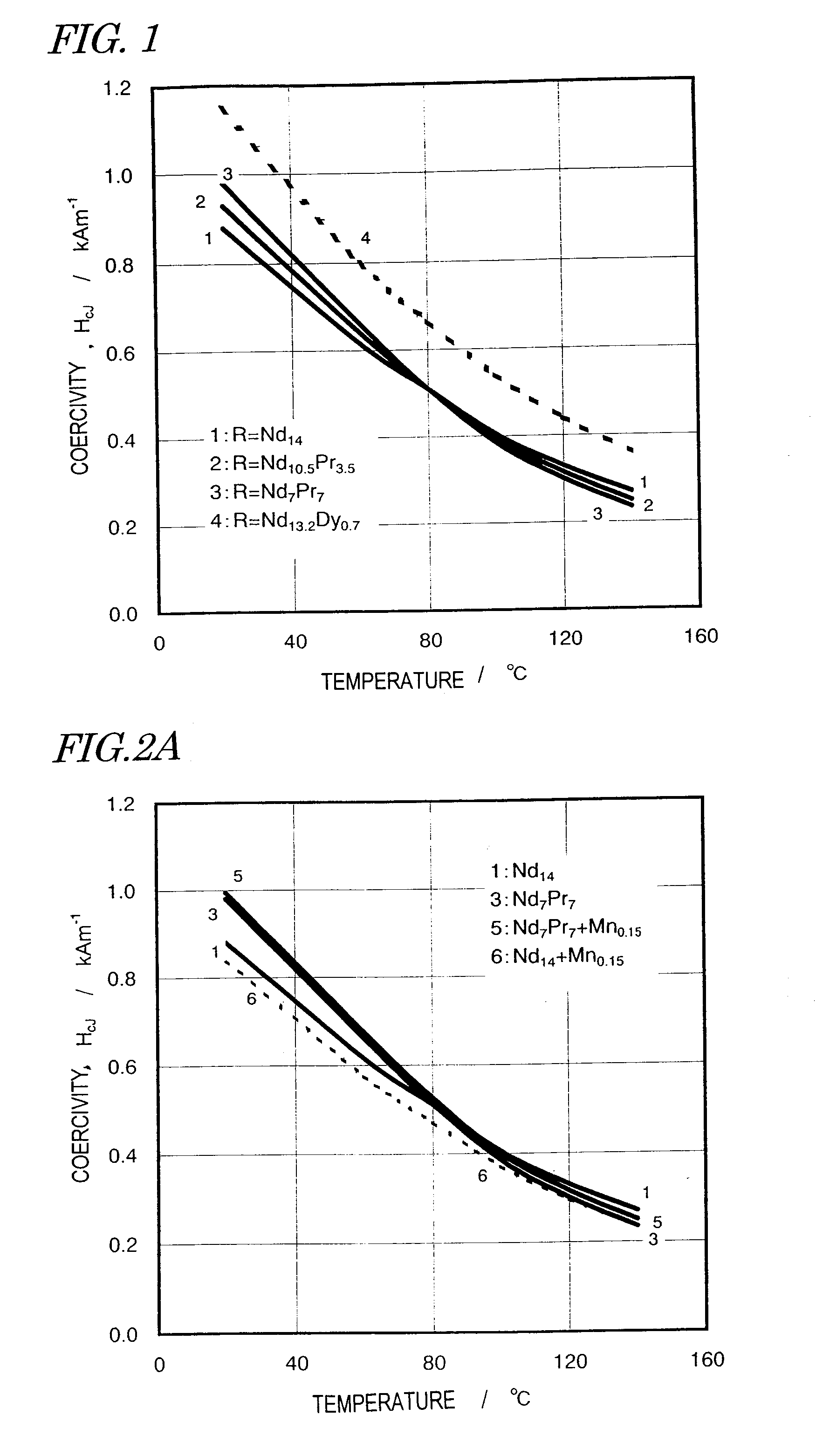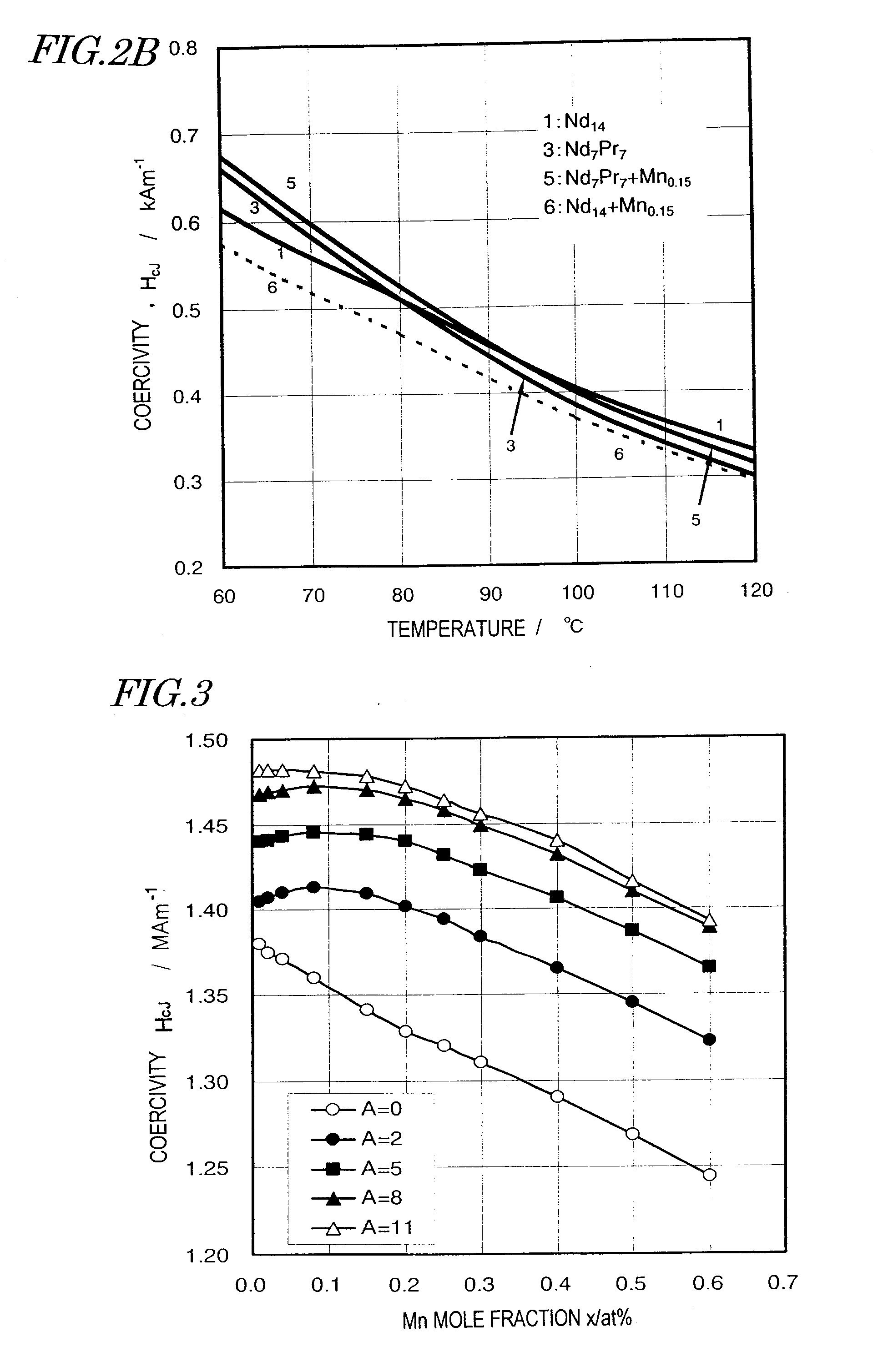R-t-b based sintered magnet
a sintered magnet and r-t-b technology, applied in the field of r-t-b based sintered magnets, can solve the problems of reducing the size of the resultant metallurgical structure reducing the size of the resultant metallurgical structure, and increasing the requirements of the ferromagnetism of the sintered body. it can promote the sintering reaction, improve the loop squareness of the demagnetization curve, and increase the coer
- Summary
- Abstract
- Description
- Claims
- Application Information
AI Technical Summary
Benefits of technology
Problems solved by technology
Method used
Image
Examples
example 1
[0083]An alloy with an objective composition was prepared by mixing together Pr and Nd with a purity of 99.5% or more, Tb and Dy with a purity of 99.9% or more, electrolytic iron, and low-carbon ferroboron alloy together with the other objective elements added in the form of pure metals. The alloy was then melted and cast by a strip casting process, thereby obtaining a plate-like alloy with a thickness of 0.3 mm to 0.4 mm.
[0084]This material alloy was subjected to a hydrogen decrepitation process within a hydrogen atmosphere with an increased pressure, heated to 600° C. in a vacuum, cooled and then classified with a sieve, thereby obtaining a coarse alloy powder with a particle size of 425 μm or less. Then, zinc stearate was added to, and mixed with, this coarse powder so as to account for 0.05 mass % of the powder.
[0085]Next, the coarse alloy powder was subjected to a dry pulverization process using a jet mill machine in a nitrogen gas flow, thereby obtaining a fine powder with a p...
example 2
[0094]Magnets, of which the compositions were represented by Nd13.5-APrADy1.0Febal.Co2.0Al0.5Cu0.1MnxB6.0 (where subscripts are atomic percentages), had their coercivity measured at room temperature with the mole fraction A of Pr set to be 0, 2, 5, 8 and 11 (at %) and with the mole fraction x of Mn varied. The results are shown in FIG. 3. The magnets of this Example 2 were produced by the same method as that adopted for Example 1.
[0095]As can be seen from FIG. 3, in a situation where A=0, as Mn was added, the coercivity decreased monotonically. On the other hand, if a portion of the rare-earth element was replaced with Pr, the coercivity rather increased as long as the amount of Mn added fell within a particular range.
[0096]However, in a situation where the mole fraction A of Pr was 11 at %, the coercivity did not increase appreciably even if Mn was added.
example 3
[0097]Sintered magnets, of which the compositions were represented by Nd11.5Pr1.0Dy1.2Febal.Cu0.1MnxB6.0 (where subscripts are atomic percentages), were made with the mole fraction x varied and had their magnetic properties measured. The results are shown in the following Table 2:
TABLE 2Mole fractionDensityMagnetic propertiesNo.x of Mn (at %)ρ / MGm−3Jr / THCJ / kAm−1Hk / HCJ210.017.341.33710260.926220.027.491.36811220.971230.057.511.37211550.989240.107.541.37611340.987250.157.531.37211190.987260.207.541.36811050.988270.257.541.36310910.987280.307.531.36010740.988290.407.541.35110400.985300.507.541.34310080.988310.607.541.3359810.983320.807.531.3169080.978
[0098]The same manufacturing process as that adopted for Example 1 was also carried out. Every magnet with any of these compositions was sintered at 1,020° C. for two hours. The magnetic properties were evaluated by calculating Hk as an index and figuring out Hk / HcJ as an index to loop squareness. In this case, Hk represents a value of a d...
PUM
| Property | Measurement | Unit |
|---|---|---|
| Curie temperature | aaaaa | aaaaa |
| thermal resistance | aaaaa | aaaaa |
| temperatures | aaaaa | aaaaa |
Abstract
Description
Claims
Application Information
 Login to View More
Login to View More - R&D
- Intellectual Property
- Life Sciences
- Materials
- Tech Scout
- Unparalleled Data Quality
- Higher Quality Content
- 60% Fewer Hallucinations
Browse by: Latest US Patents, China's latest patents, Technical Efficacy Thesaurus, Application Domain, Technology Topic, Popular Technical Reports.
© 2025 PatSnap. All rights reserved.Legal|Privacy policy|Modern Slavery Act Transparency Statement|Sitemap|About US| Contact US: help@patsnap.com



